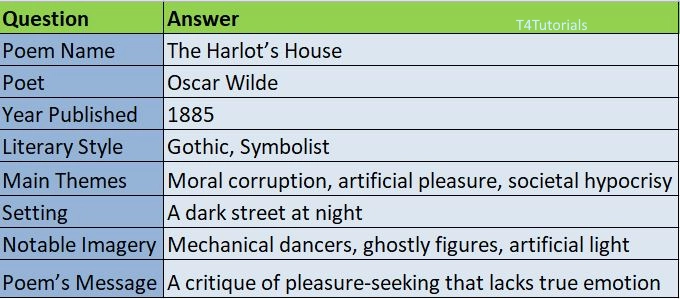Summary:
“The Harlot’s House” is a poem by Oscar Wilde, published in 1885. It is a dark and haunting depiction of a brothel, symbolizing moral decay, lost love, and the artificial nature of pleasure. The poem describes a couple walking past a house of prostitution at night. The house is filled with mechanical, ghostly figures dancing, emphasizing the lifeless, soulless nature of those inside. The imagery of the poem suggests that these people are trapped in a world of empty pleasures and moral corruption. Wilde contrasts the artificiality of the harlot’s house with the sincerity of real love. The speaker’s companion, a woman, is eventually drawn into the house, leaving him behind, which symbolizes how people can be tempted by sinful pleasures and abandon true love. The poem critiques Victorian society’s hidden hypocrisy, where outward morality coexists with secret indulgences in vice. It also reflects Wilde’s decadent aestheticism, showing the dark side of human desires.
10
Score: 0
Attempted: 0/10
Subscribe
| Question | Answer |
| Poem Name | The Harlot’s House |
| Poet | Oscar Wilde |
| Year Published | 1885 |
| Literary Style | Gothic, Symbolist |
| Main Themes | Moral corruption, artificial pleasure, societal hypocrisy |
| Setting | A dark street at night |
| Notable Imagery | Mechanical dancers, ghostly figures, artificial light |
| Poem’s Message | A critique of pleasure-seeking that lacks true emotion |